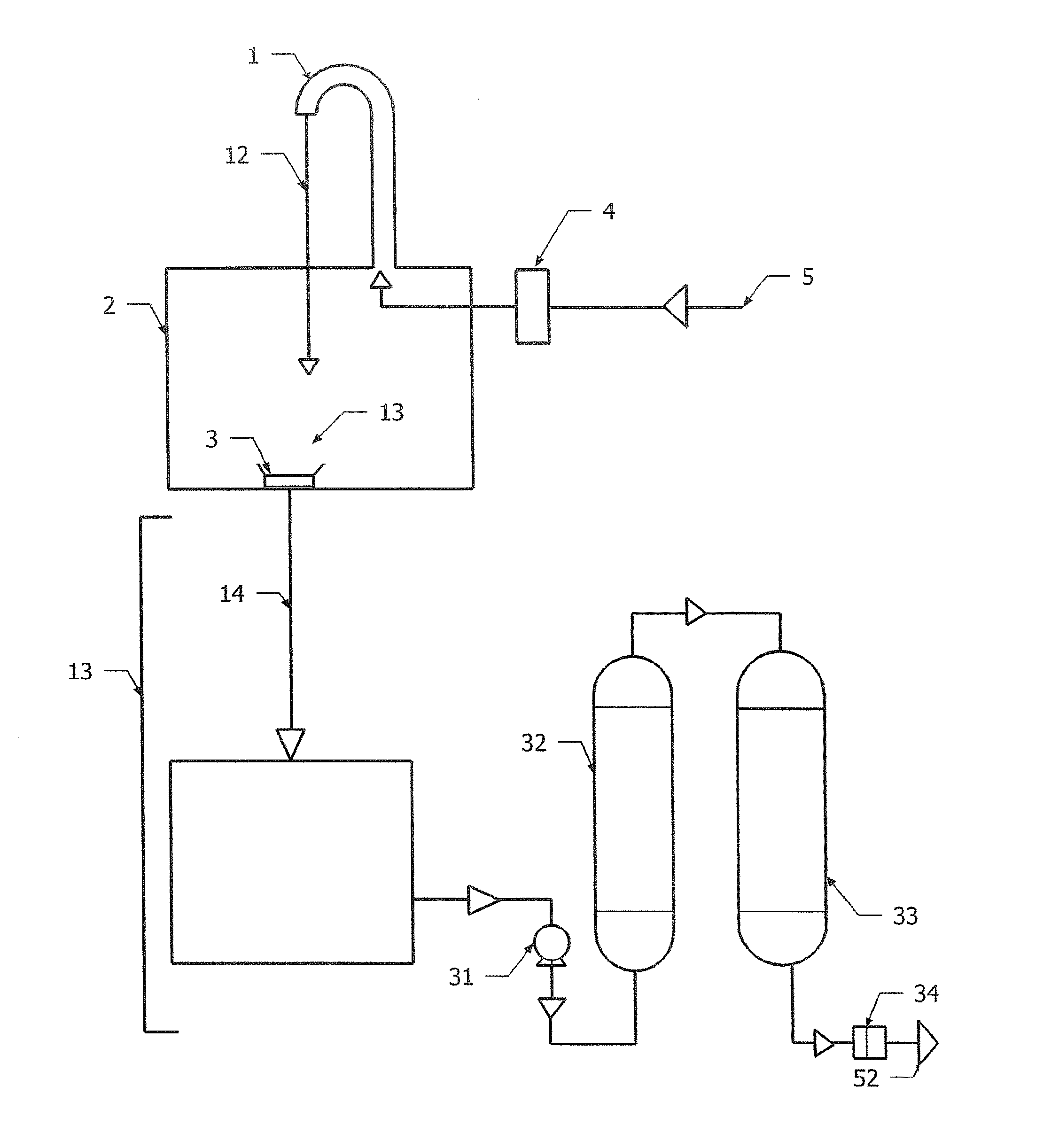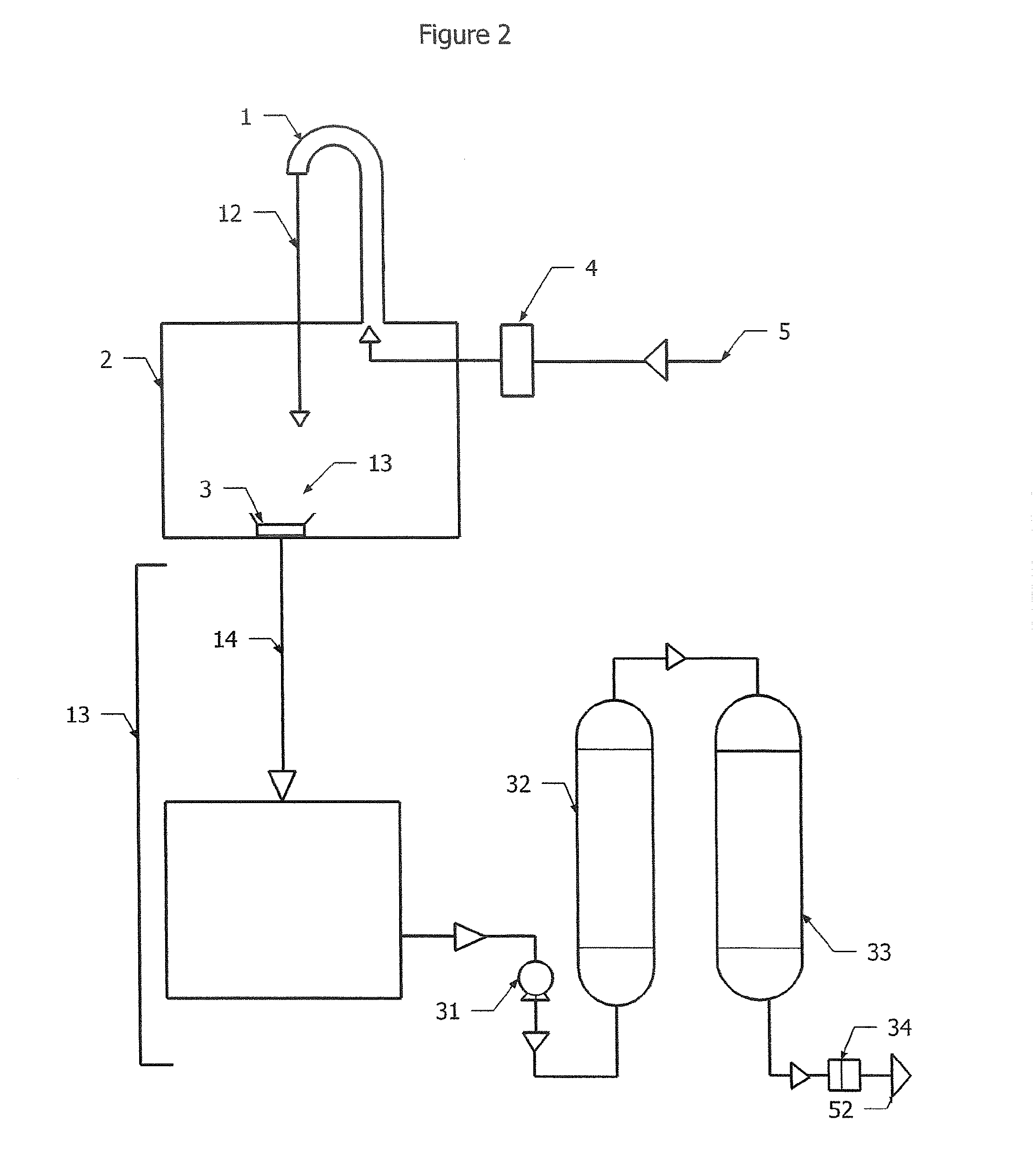Point of generation small volume bioreactor for hormone and endocrine disrupting chemical remediation
- Summary
- Abstract
- Description
- Claims
- Application Information
AI Technical Summary
Benefits of technology
Problems solved by technology
Method used
Image
Examples
example 1
[0103]A compounding pharmacy produces 40 gallons of hormone wastewater per day. Hours of operation are 9 am-5 pm, 5 days a week. The average concentration of hormone waste to the retention tank is 10 mg / L (CO). The bed volumes of both the BAC (Vb) and GAC(Vg) are 400m1 and the full reactor sizes are each 600 ml, (VB and VG). After flowing through the BAC the concentration (Ci) of hormones is 30 micrograms / L (3.0×10-2 mg / L) and after flowing through the GAC the concentration (Ce) is 0.01 nanograms / L (1.0×10-8 mg / L) returned to the municipal wastewater stream. Example 1 is a simple demonstration for calculating reactor size based on desired flow rate and Empty Bed Contact Time.[0104]GAC particle size is 1.0 mm and bulk density of 1.0 mm GAC (d) is 0.5 g / cc[0105]Empty bed contact time, EBCT (t) is 5.5 min[0106]Maximum flow rate (Q in reactors is 75 ml / min[0107]Volume of water to be treated (VR)
40 gal / d (3.785 L / gal)=150 L / d
150 L / d (5 d / wk)=750 L / wk
VR=750 L / wk / 7 d / wk=107 L / d contaminate...
example 2
[0116]In a dwelling, resides a family including a female of reproductive age using synthetic estrogen (i.e.EE2) dosed a 35 mcg / day orally for purposes of birth control. In addition there is a post menopausal female relative that lives in the dwelling. She uses progesterone (200 mg / d), estradiol (2 mg / d) and testosterone (2 mg / d) prescribed by her physician for controlling menopausal symptoms. An estimated 90% of hormones are excreted through the urine in humans.
Ex. 2.0
[0117]
0.0035 mg (EE2)+20 mg (P)+2 mg (E2)+2 mg (T)=200.0035 mg hormone consumed
200.0035 mg×0.90=183.60315 mg / day hormone excreted
183.60315 mg / d×365 d / yr=67,015.14975 mg / year=67.015 grams / year
[0118]GAC cartridges utilized in a modified toilet designed for the adsorption of synthetic and bioidentical hormones would sequester the hormones, thus removing them from the wastewater at the point of introduction into the community wastewater treatment system. In addition, any over the counter ibuprofen, for example consumed wou...
example 3
[0122]In 2006 the US dairy cow population produced 80 tons (72,574.8 kg) of estradiol (E2) alone per year, (2060 mcg / cow / day). If microbial application to dairy cattle excrement could reduce that number even by 50%, it would significantly reduce the estrogen loads on the environment.
PUM
| Property | Measurement | Unit |
|---|---|---|
| Fraction | aaaaa | aaaaa |
| Fraction | aaaaa | aaaaa |
| Time | aaaaa | aaaaa |
Abstract
Description
Claims
Application Information
 Login to View More
Login to View More - R&D
- Intellectual Property
- Life Sciences
- Materials
- Tech Scout
- Unparalleled Data Quality
- Higher Quality Content
- 60% Fewer Hallucinations
Browse by: Latest US Patents, China's latest patents, Technical Efficacy Thesaurus, Application Domain, Technology Topic, Popular Technical Reports.
© 2025 PatSnap. All rights reserved.Legal|Privacy policy|Modern Slavery Act Transparency Statement|Sitemap|About US| Contact US: help@patsnap.com



